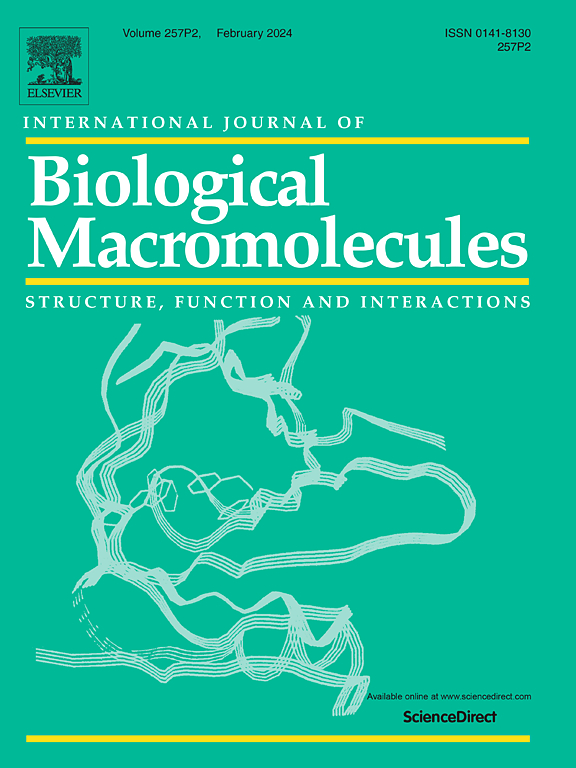Carboxymethyl chitosan derived Nx-C integrated with adjacent redox half reactions (MnCoSnO3): A dynamic contender for wastewater decontamination
IF 7.7
1区 化学
Q1 BIOCHEMISTRY & MOLECULAR BIOLOGY
International Journal of Biological Macromolecules
Pub Date : 2025-07-05
DOI:10.1016/j.ijbiomac.2025.145757
引用次数: 0
Abstract
Construction of integrated photo-induced and spatially adjacent redox half reactions dual site photocatalysts to boost their synergy for practical applications renders substantial challenges. Here in Mn0.5Sn2Co0.5O3 (MSCO) was integrated with carboxymethyl chitosan derived Nx-C (CMChi-C) for the first time to fabricate Mn0.5Sn2Co0.5O3-CMChi-C (MSCO-CMChi-C) composite. The fabricated photocatalyst was investigated by various characterizations such as FTIR, XRD, EDS, XPS, SEM, H-NMR, HR-TEM, SAED etc. The composition, shape, morphology, structural information confirms the successful synthesis of MSCO-CMChi-C. The tailored MSCO-CMChi-C material achieved 95 % tetracycline (TCs) degradation which is 2.968, 1.301 and 0.84 times greater than SCO, MSCO, and MSCO@N-Chi-C respectively. Results showed that 73.15 % TCs photodegradation (2.29 times greater than SCO) executed by the spatial adjacent redox interface (Mn![]() Co) utilizing spin polarization to hinder charge recombination inside atomic vicinity of MSCO. The higher photocatalytic efficiency of MSCO-CMChi-C has stemmed by addressing persistent dysfunctions/defects succeeding in poor light harvesting ability of semiconductors, low carrier mobility and short exciton diffusion tailed with organic polymer. The MSCO-CMChi-C was further used for MB and EB dyes degradations, resulting in 90 and 96 % degradation in 40 min of visible light irradiation respectively. The higher photocatalytic activity of MSCO-CMChi-C resulted from conferring and integration of structural and functional characteristics of individual components. The spatial adjacent sites (Mn
Co) utilizing spin polarization to hinder charge recombination inside atomic vicinity of MSCO. The higher photocatalytic efficiency of MSCO-CMChi-C has stemmed by addressing persistent dysfunctions/defects succeeding in poor light harvesting ability of semiconductors, low carrier mobility and short exciton diffusion tailed with organic polymer. The MSCO-CMChi-C was further used for MB and EB dyes degradations, resulting in 90 and 96 % degradation in 40 min of visible light irradiation respectively. The higher photocatalytic activity of MSCO-CMChi-C resulted from conferring and integration of structural and functional characteristics of individual components. The spatial adjacent sites (Mn![]() Co) of MSCO facilitates redox reactions utilizing spin polarization at same time integration of the CMChi derived Nx-C enhances light sensitivity and charge mobility intrigue exceptional physiochemical properties exhibited by MSCO-CMChi-C.
Co) of MSCO facilitates redox reactions utilizing spin polarization at same time integration of the CMChi derived Nx-C enhances light sensitivity and charge mobility intrigue exceptional physiochemical properties exhibited by MSCO-CMChi-C.

羧甲基壳聚糖衍生的Nx-C及其邻氧化还原半反应(MnCoSnO3):废水净化的动态竞争者。
构建集成光诱导和空间相邻氧化还原半反应的双位点光催化剂以提高其协同作用在实际应用中提出了重大挑战。本文首次将Mn0.5Sn2Co0.5O3 (MSCO)与羧甲基壳聚糖衍生的Nx-C (CMChi-C)结合制备了Mn0.5Sn2Co0.5O3-CMChi-C (MSCO-CMChi-C)复合材料。采用FTIR、XRD、EDS、XPS、SEM、H-NMR、HR-TEM、SAED等多种表征手段对制备的光催化剂进行了表征。MSCO-CMChi-C的组成、形状、形态、结构信息证实了MSCO-CMChi-C的成功合成。量身定制的MSCO- cmci - c材料对四环素(tc)的降解率为95% %,分别是SCO、MSCO和MSCO@N-Chi-C的2.968倍、1.301倍和0.84倍。结果表明,空间相邻氧化还原界面(MnCo)利用自旋极化阻碍MSCO原子附近的电荷复合,实现了73.15% %的TCs光降解(比SCO高2.29倍)。MSCO-CMChi-C的高光催化效率源于解决了半导体光捕获能力差、载流子迁移率低和短激子扩散与有机聚合物的持续功能障碍/缺陷。MSCO-CMChi-C进一步用于MB和EB染料的降解,在40 min的可见光照射下,降解率分别达到90%和96% %。MSCO-CMChi-C具有较高的光催化活性是由于其各组分的结构和功能特性的赋予和整合。MSCO的空间邻位(MnCo)有利于利用自旋极化进行氧化还原反应,同时CMChi衍生的Nx-C的集成提高了MSCO-CMChi- c的光敏性和电荷迁移率,并激发了MSCO-CMChi- c所表现出的特殊物理化学性质。
本文章由计算机程序翻译,如有差异,请以英文原文为准。
求助全文
约1分钟内获得全文
求助全文
来源期刊
CiteScore
13.70
自引率
9.80%
发文量
2728
审稿时长
64 days
期刊介绍:
The International Journal of Biological Macromolecules is a well-established international journal dedicated to research on the chemical and biological aspects of natural macromolecules. Focusing on proteins, macromolecular carbohydrates, glycoproteins, proteoglycans, lignins, biological poly-acids, and nucleic acids, the journal presents the latest findings in molecular structure, properties, biological activities, interactions, modifications, and functional properties. Papers must offer new and novel insights, encompassing related model systems, structural conformational studies, theoretical developments, and analytical techniques. Each paper is required to primarily focus on at least one named biological macromolecule, reflected in the title, abstract, and text.

 求助内容:
求助内容: 应助结果提醒方式:
应助结果提醒方式:


